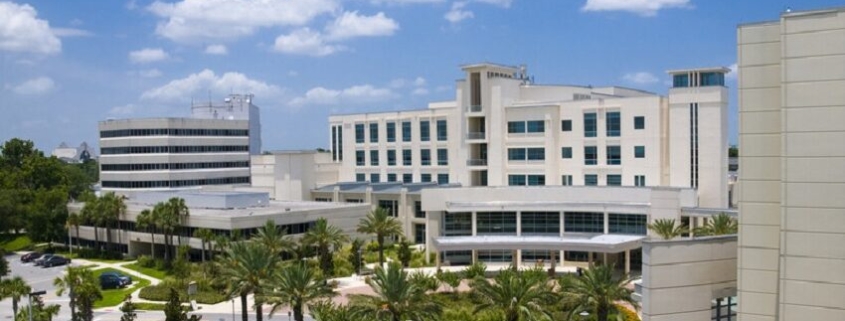Hospitals Buying Real Estate, Revamping Clinical Space For Innovation Hubs
In February, Pittsburgh-based Allegheny Health Network held a ribbon-cutting in Bellevue, Pennsylvania, to unveil a home for one of its newest ventures—AlphaLab Health, which the system hopes will spur innovation and improvements to community health.
The 10,000-square-foot innovation hub, a partnership with Pittsburgh-based startup incubator Innovation Works, is housed in a former hospital owned by AHN. It will serve as the home base for startups participating in AlphaLab Health, AHN’s healthcare and life sciences startup accelerator launched in fall 2020.
“It’s a demonstration of what you can do to repurpose these assets that are aged but have great bones,” said Dr. Jeff Cohen, AHN’s chief physician executive for community health and innovation.
The space gives AlphaLab Health startups access to wet and dry labs to develop products, as well as office space and areas to collaborate and meet with other startups. The startups also receive early-stage funding and opportunities to connect with clinicians and test products at AHN.
The project has involved more than two years and $5 million, including renovations and investments in startups and programing—of which AHN and its parent Highmark Health contributed $2 million.
“Accelerators and other innovation centers became more popular during the COVID-19 pandemic,” said Pam Arlotto, president and CEO of healthcare consultancy Maestro Strategies.
While hospitals have been setting up innovation programs for years, the efforts took on a new focus as the healthcare industry eyed consumerism and pushed to create new care models that engage patients at home and outside of the hospital. They’re expensive projects, usually involving investments in real estate and hiring staff to run the programs.
“Hospitals starting innovation centers have done everything from revamping old clinical or administrative space to building new facilities to house innovation programs,” said Rob Lowe, CEO of Wellspring, a software company that sells products for innovation and research and development programs. “It depends what type of work the hospital needs to do or the form of the incubator itself. Some hospitals create accelerators to identify startups worth partnering with or venture capital arms that invest. Some, like AHN’s, are partially funded through local government as part of economic development efforts. Almost in all cases of these hospitals that we work with around the U.S., we see dedicated space.”
A Hospital Makeover
The vision for AlphaLab Health started in 2019. Cohen, then president of the system’s Allegheny General Hospital, wanted to embark on a community health project. He requested that the health system let him start an accelerator at a nearby facility that Allegheny General was responsible for—a 240,000-square-foot facility about 6 miles away in Bellevue, which closed its inpatient units and emergency department in 2010.
The hospital, formerly AGH Suburban, had transitioned into a nursing facility, but that closed in 2019. AHN continues to operate an urgent care center and outpatient clinics at the facility. It required significant renovations to become AlphaLab Health.
The facility’s intensive-care units were transformed into lab space, patient rooms turned into office space, and waiting rooms became conference space. Startups aren’t charged rent while participating in the accelerator but can choose to continue to rent office space from AlphaLab Health after the six-month program comes to an end.
Cohen is curious whether this model, should it prove successful, could be used in other regions. He said many hospital closures have left vacant facilities in poor areas. In rural areas alone, more than 181 hospitals have closed nationwide since 2005, according to the North Carolina Rural Health Research Program.
But initiatives like AlphaLab Health could help turn around that blight by creating jobs in underserved areas, lifting community health and improving medical care with new innovations. Jobs could serve to decrease the cost of care, since research has suggested employment is a social determinant of health.
To renovate the former hospital, AlphaLab Health raised funds from government, philanthropy and AHN’s parent company Highmark Health. The funding included a grant from the Pennsylvania Department of Community and Economic Development, which will reimburse $500,000 in construction costs from its Redevelopment Assistance Capital Program. More than 181 hospitalshave closed since 2005 in rural areas alone, according to the North Carolina Rural Health Research Program.
Each startup also receives up to $100,000 in funding—half of which is provided by AHN, and the other half from Innovation Works. AlphaLab Health retains 2% equity. AlphaLab Health accepted its first class of seven startups in 2020, six startups in 2021 and received more than 100 applicants each year.
AlphaLab Health is tracking a few metrics to gauge success, including follow-on funding that startups receive after the accelerator. Already, five of the first 13 startups have raised an estimated $10 million in additional funding, Cohen said. Six companies have started tests of their products and five have hired at least one new local full-time employee.
“We’ve been very early, but so far we’re very pleased with the direction of where this is going,” Cohen said.
Spinning Off Innovation
Milwaukee-based Froedtert and the Medical College of Wisconsin launched Inception Health, a program that develops innovations and evaluates digital tools in the market, seven years ago. It’s a separate company owned by Froedtert and MCW, housed in a 10,000-square-foot office space in the health system’s North Hills Health Center.
“The office was previously used for outpatient ambulatory services but was revamped to be a classic innovation space,” said Cathy Jacobson, Froedtert’s president and CEO. “The team needed dedicated meeting areas, since it’s often bringing in external partners and vendors. It couldn’t just be a conference room buried within a hospital. Inception Health was set up as a limited-liability corporation owned and funded by Froedtert so that innovative ideas wouldn’t have to compete for resources with the traditional health system.”
Inception Health’s projects must align with challenges and goals outlined in Froedtert’s strategic plan, such as patient access, consumer experience and population health. The company’s board is made up of C-suite executives from Froedtert and chaired by Jacobson. Inception Health’s annual budget has increased over the years, from roughly $2.5 million in 2015 to $10 million.
“The board evaluates return on investment across the portfolio rather than for individual projects, according to Jacobson. “That factors in care quality and consumer access improvements. We want the ability to experiment and fail.”
Inception Health doesn’t sell services to other health systems. It does have one hospital that pays to be a partner, which means it’s able to deploy tools that Inception Health has developed and assessed. Inception Health is working to onboard another hospital partner.
“Froedtert is still fine-tuning how to design innovations with full-scale deployment in mind, beyond the initial pilot or experiment,” Jacobson said.
While Inception Health’s charter is to develop innovations, it doesn’t implement them. That’s handled by Froedtert’s operations team. Once an innovation is developed, Froedtert’s team will work with Inception Health to pilot the new product or process at the health system. But Jacobson said leadership has realized they need to build up that implementation capacity and dedicate more staff to scaling an innovation across the health system after a successful pilot, similar to how IT workers home in on EHR work during a go-live or upgrade.
“You always staff an EHR implementation,” Jacobson said. “We weren’t doing it with the same rigor with Inception.”
Creating a business plan with next steps for after product development and piloting technology is critical for a successful innovation center, said Ash Shehata, national sector leader for healthcare and life sciences at consulting firm KPMG. That could include how to scale it across the health system for an internal return on investment, as well as considering whether to commercialize the intellectual property and sell to peers.
“Without that business plan, it’s easy to get stuck in a prototype phase,” Jacobson said.
A Pandemic Shift
Cedars-Sinai in Los Angeles has run a startup accelerator since 2016 to connect with early-stage companies.
“The Cedars-Sinai Accelerator provides an entry point for the health system’s work with startups,” said Jim Laur, vice president of technology transfer and business affairs at the system.
It’s a three-month program in which startups work with hospital staffers who have identified problems to develop possible pilots. Cedars-Sinai has hosted seven accelerator cohorts with about eight to 10 startups in each.
“Usually, each class has at least two or three startups that end up launching a pilot and subsequently providing services to the health system,” Laur said.
The accelerator is hosted in the Cedars-Sinai Innovation Space, a two-story, 10,000-square-foot building across the street from Cedars-Sinai Medical Center. Being across the street was important for the accelerator, making it easy for startup founders to walk to the hospital to talk with staff and see workflows in action.
“We thought it would be good to have a space that’s on its own for a specific purpose … while still being just across the street,” Laur said. “People can still connect really easily.”
It’s a repurposed building that was originally a retail space, which meant Cedars-Sinai had to do some minimal renovations, like taking out the store counters and putting in conference rooms.
“The goal for the Cedars-Sinai Accelerator is to bring solutions to clinicians and business leaders at the hospital,” Laur said. “It’s not expected to drive a financial return for the health system.”
Laur’s team has found ways to measure the accelerator’s performance and whether it’s succeeding in identifying high-impact startups. The team tracks the number of employees that a startup has before and after the program, to see whether the company has grown. They also track funding the company raises after the program.
Cedars-Sinai took a break from using the innovation space during the COVID-19 pandemic, when the accelerator shifted to a virtual model. During that time, the building was used to create supplies like hand sanitizer and face shields during shortages.
Moving forward, the accelerator plans to take some lessons from the pandemic. Leaders are looking to maintain a virtual option for startups that may not be able to relocate, only bringing them to Los Angeles for a portion of the program focused on things that are hard to replicate remotely, like walking through the hospital floors. It will continue to offer educational sessions virtually, which leaders hope will create opportunities for entrepreneurs with families or other responsibilities that make it challenging to move for three months.
“We’re able to now accommodate a broader range of individual circumstances,” Laur said. “It’s really been an exciting refresh for the program.”
The pandemic’s push toward more remote and hybrid work could lead to more innovation centers, KPMG’s Shehata suggested. As organizations downsize office space where back-office employees used to work, that space will need a new purpose.
“Health systems need to reconsider what they want to do with it,” Laur said. “They could offload it to reap the savings or transform it into something new.”
Building From The Ground Up
Peoria, Illinois-based OSF HealthCare has operated a 168,000-square-foot innovation center, dubbed the Jump Trading Simulation and Education Center, since 2013.
“It was new construction,” said Dr. John Vozenilek, vice president and chief medical officer for innovation and digital health at OSF HealthCare.
Jump Simulation, which cost an estimated $55 million to build, is attached to the system’s St. Francis Medical Center in Peoria The building was funded through a $25 million donation from trading firm Jump Trading, as well as private donors and OSF HealthCare. It’s a partnership with the University of Illinois College of Medicine at Peoria.
The building’s first two floors comprise simulation spaces, including an operating theater, inpatient and outpatient settings, and a home environment with an ambulance used for medical training, The floors above are innovation spaces, where teams of engineers and clinicians design and build solutions—and then test them in the simulation spaces below. The innovation spaces house seven labs focused on research and development for topics like children’s healthcare, data science and informatics, and advanced imaging and modeling, among others.
OSF HealthCare’s Jump Simulation innovation hub houses a simulated operating theater and inpatient and outpatient settings for medical training.
The labs often work with external partners who have expertise in their given focus area, as well as professors and students from nearby universities.
“The labs almost serve as a beacon, letting outside experts know that this is an area OSF HealthCare is investing in and is interested in expanding,” according to Vozenilek. “That’s really accelerated our whole process. For the model to be successful, the work in the lab can’t just stay there. It has to be translated back into hospital operations or patient care,’OSF leadership monitors the labs’ progress based on whether they’re producing new ideas and the extent to which those ideas are getting disseminated into the hospital and throughout the industry.”
“The vision behind Jump Simulation is to improve outcomes and cut costs through innovative training, as well as finding better ways to perform clinical care,” said Dr. Lisa Barker, chief medical director at the Jump Simulation center. “To demonstrate the value of Jump Simulation’s work to health system leadership, the team often measures ROI based on cost avoidance. That includes figuring out how programs at the center contribute to reductions in medical errors and complications or creating efficiencies when onboarding new medical professionals. Not only do we have a qualitative impact, but we can have a tangible benefit as well.”
Source: Modern Healthcare










